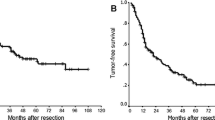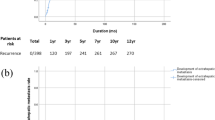Summary
The clinicopathological features showing the malignancy of hepatocellular carcinoma were investigated by retrospectively analyzing the postoperative prognosis after hepatic resection. The long-term prognosis was stongly affected by the existence of portal tumor invasion or intrahepatic metastasis as indicated by the following results. The 3-year cumulative survival rates were 61% and 38% for patients in portal vein tumor invasion groups (Vp0 and Vp1 (P<0.05). No patients with Vp2 or Vp3 could survive beyond 3 years after hepatic resection. Similarly, patients with intrahepatic metastasis IM0 showed a better prognosis, compared to those with IM2 or IM3 (P<0.05). In addition, the grade of tumor cell anaplasia to some extent affected the prognosis, but not the tumor growth pattern at the tumor/non-tumor boundary. The tumor growth rate, estimated by the α-fetoprotein doubling time, was not connected with venous invasion or intrahepatic metastasis, but it became shorter at the time of a recurrence. It is concluded that, from the standpoint of a long-term prognosis, the pathological features showing malignancy appear in venous invasion and intrahepatic metastasis.
Similar content being viewed by others
References
Collins VP, Loeffler RK, Tivey H (1956) Observations on growth rates of human tumors. Am J Roentgenol 76: 988
Edmondson HA, Steiner P (1954) Primary carcinoma of the liver. A study of 100 cases among 48 900 necropsies. Cancer 4: 462
Hattori T, Hosokawa Y, Fukuda M, Sugihara H, Hamada S, Takamatsu T, Nakanishi K, Tsuchihashi Y, Kitamura T, Fujita S (1984) Analysis of DNA ploidy patterns of gastric carcinoma of Japanese. Cancer 54: 159
Liver Cancer Study Group of Japan (1983) The general rules for the clinical and pathological study of primary liver cancer. Kanahara Press, Tokyo
Matsumoto Y, Suzuki T, Asada I, Ozawa K, Tobe T, Honjo I (1982) Clinical classification of hepatoma in Japan according to serial changes in serum alpha-fetoprotein levels. Cancer 49: 354
Nakashima T, Kojiro M (1986) Pathologic characteristic of hepatocellular carcinoma. Semin Liver Dis 6: 259
Ozawa K, Ida T, Yamada T, Yamaoka Y, Takasan H, Honjo I (1975) Oral glucose tolerance test in patients with jaundice. Surg Gynecol Obstet 140: 582
Schirrmacher U (1985) Adv Cancer Res 43: 1
Schwartz M (1961) A biomathematical approach to clinical tumor growth. Cancer 14: 1272
Shew JC, Sung JL, Chen DS, Yang PM, Lai MY, Lee CS, Hsu HC, Chuang CN, Yang PC, Wang TH, Lin JT, Lee CZ (1986) Growth rate of asymptomatic hepatocellular carcinoma and its clinical implications. Gastroenterology 89: 259
Yamanaka N, Okamoto E, Kuwata K, Tanaka N (1984) A multi regression equation for prediction of posthepatectomy liver failure. Ann Surg 200: 658
Author information
Authors and Affiliations
Rights and permissions
About this article
Cite this article
Tanaka, J., Tobe, T., Morino, T. et al. Clinicopathological features of malignancy in hepatocellular carcinoma. Cancer Chemother. Pharmacol. 23 (Suppl 1), S96–S100 (1989). https://doi.org/10.1007/BF00647250
Issue Date:
DOI: https://doi.org/10.1007/BF00647250




